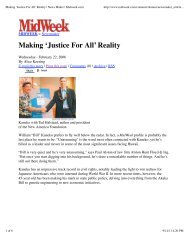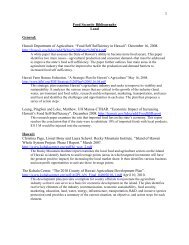Hawai'i Fisheries Initiative - The Hawaii Institute for Public Affairs
Hawai'i Fisheries Initiative - The Hawaii Institute for Public Affairs
Hawai'i Fisheries Initiative - The Hawaii Institute for Public Affairs
Create successful ePaper yourself
Turn your PDF publications into a flip-book with our unique Google optimized e-Paper software.
due to the freshness of the fish when it<br />
comes to market and careful on-board<br />
handling. 67 Trollers share the burnt tuna<br />
problem with handliners; charter boats<br />
have a more difficult time with this issue<br />
due to increased fight time using a rod<br />
and reel – shorter fight times and faster<br />
chilling equal better-quality fish. 68<br />
Fishers have control over the<br />
following factors:<br />
u Freshness: length of the fishing trip and<br />
at-sea handling of catch.<br />
Seafood Quality Control and Safety<br />
Fish marketability is dependent on many<br />
factors, including a fish’s “shelf life,” which<br />
is a judgment of quality parameters, such as<br />
its intended use (sashimi, grilled, smoked,<br />
etc.), grade, and the wholesomeness of the<br />
fish, which is largely due to characteristics<br />
of the particular species and on-board<br />
handling. Longer shelf life plus high quality<br />
equal high prices. Tuna caught by longline<br />
are generally thought to be of higher<br />
quality than tuna caught by other methods.<br />
One reason is that the handline tuna fishery<br />
struggles with “burnt tuna syndrome,”<br />
thought to be related to the time a fish<br />
fights on the line, which alters its body<br />
chemistry and temperature. Burnt tuna’s<br />
market options are limited; its quality suited<br />
only to grilling. 66 Trolling is said to<br />
produce the best quality mahimahi and ono,<br />
u Initial handling: rough handling, dragging,<br />
bending, or dropping ruins appearance,<br />
and also causes loss of a fish’s firm<br />
consistency and may cause cracking.<br />
If fish are landed alive, they should be bled<br />
immediately. Bleeding a fish, especially one<br />
with red muscle tissue like tuna, removes<br />
the iron and copper, which if not removed<br />
promote oxidation and rancidity. Removal<br />
through immediate bleeding extends shelf<br />
life and marketability.<br />
u If a fish is left <strong>for</strong> an extended period of<br />
time after capture, the original bright body<br />
colors will bleach, causing a loss of flesh<br />
color and a decrease in quality.<br />
u Chilling: After a fish is bled, it is submerged<br />
in an ice-seater brine to bring down the core<br />
temperature. After bleeding, and if a fish is<br />
landed dead (often the case in longlining),<br />
catch is individually stored on ice.<br />
u Fishers can not control other factors<br />
affecting fish quality, such as spawning.<br />
Prior to spawning, most fish feed<br />
voraciously and increase body-fat content,<br />
20







